2007 MERCEDES-BENZ C-CLASS ESTATE towing
[x] Cancel search: towingPage 151 of 377
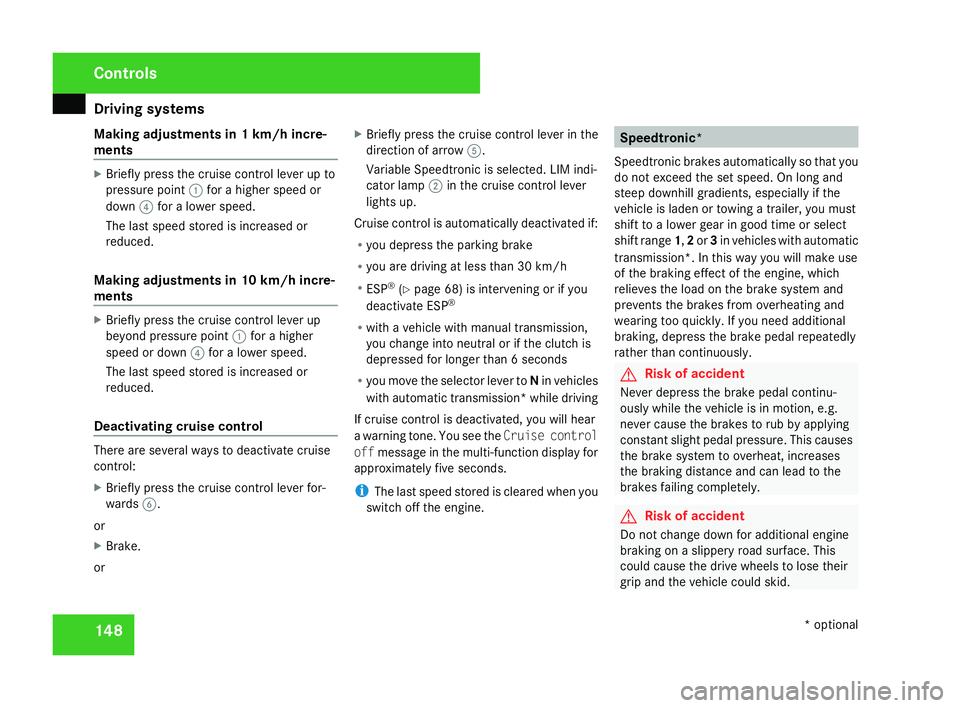
Driving sys
tems 14
8
Making adjustments in 1 km/h incre-
ments X
Briefly press the cruise control lever up to
pressure point 1for a higher speed or
down 4for a lower speed.
The last speed stored is increased or
reduced.
Making adjustments in 10 km/h incre-
ments X
Briefly press the cruise control lever up
beyond pressure point 1for a higher
speed or down 4for a lower speed.
The last speed stored is increased or
reduced.
Deactivating cruise control There are several ways to deactivate cruis
e
control :
X Briefly press the cruise control lever for-
wards 6.
or
X Brake .
or X
Briefly press the cruise control lever in the
direction of arrow 5.
Variable Speedtronic is selected. LIM indi-
cator lamp 2in the cruise control lever
lights up.
Cruise control is automatically deactivated if:
R you depress the parking brak e
R you are driving at less than 30 km/h
R ESP ®
(Y page 68) is intervening or if you
deactivate ESP ®
R with a vehicle with manual transmission ,
you change into neutral or if the clutch is
depressed for longer than 6 seconds
R you move the selector lever to Nin vehicles
with automatic transmission* while drivin g
If cruise control is deactivated, you will hear
a warning tone. You see the Cruise control
off message in the multi-function display for
approximately five seconds.
i The last speed stored is cleared when you
switch off the engine. Speedtronic*
Speedtronic brakes automatically so that you
do not exceed the set speed. On long and
steep downhill gradients, especially if the
vehicle is laden or towing a trailer, you must
shift to a lower gear in good time or select
shift range 1,2 or 3in vehicles with automatic
transmission*. In this way you will make use
of the braking effect of the engine, which
relieves the load on the brake system and
prevents the brakes from overheating and
wearing too quickly. If you need additional
braking, depress the brake pedal repeatedly
rather than continuously. G
Risk of accident
Never depress the brake pedal continu -
ously while the vehicle is in motion, e.g.
never cause the brakes to rub by applying
constant slight pedal pressure. This causes
the brake system to overheat, increases
the braking distance and can lead to the
brakes failing completely. G
Risk of accident
Do not change down for additional engine
braking on a slippery road surface. Thi s
could cause the drive wheels to lose thei r
grip and the vehicle could skid. Controls
* optional
204_AKB; 2; 3, en-GB
mkalafa,
2007-06-26T23:11:51+02:00 - Seite 148
Page 158 of 377
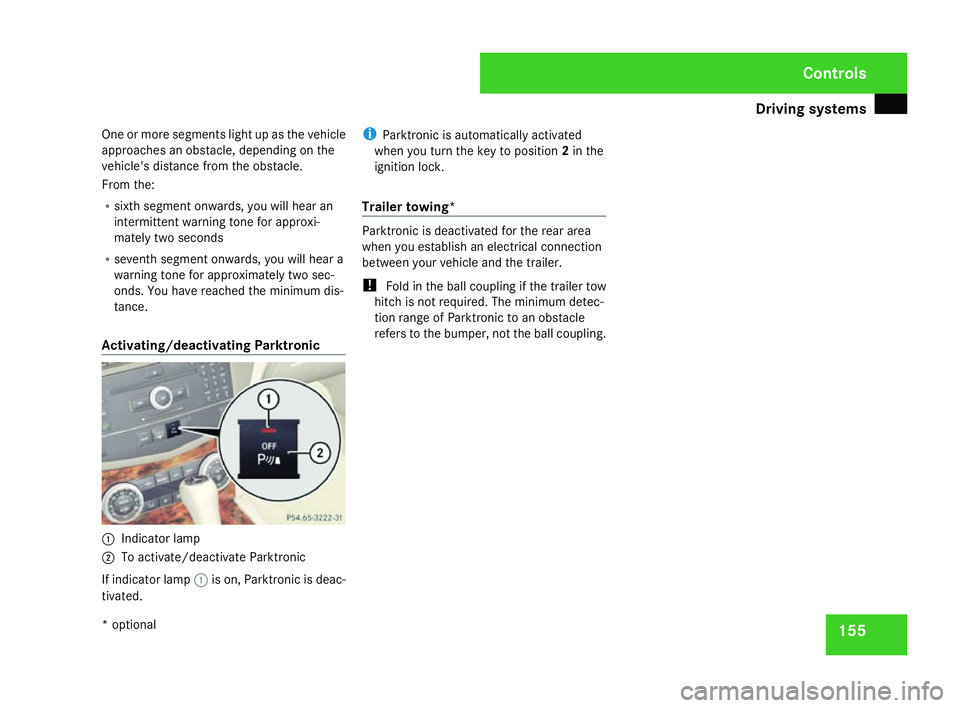
Driving sys
tems 15
5
One or more segments light up as the vehicle
approaches an obstacle, depending on the
vehicle's distance from the obstacle.
From the:
R sixth segment onwards, you will hear an
intermittent warning tone for approxi-
mately two seconds
R seventh segment onwards, you will hear a
warning tone for approximately two sec -
onds. You have reached the minimum dis-
tance.
Activating/deactivating Parktronic 1
Indicator lamp
2 To activate/deactivate Parktronic
If indicator lamp 1is on, Parktronic is deac-
tivated. i
Parktronic is automatically activated
when you turn the key to position 2in the
ignition lock .
Trailer towing* Parktronic is deactivated for the rear area
when you establish an electrical connectio
n
between your vehicle and the trailer.
! Fold in the ball coupling if the trailer tow
hitch is not required. The minimum detec -
tion range of Parktronic to an obstacle
refers to the bumper, not the ball coupling . Cont
rols
* optional
204_AKB; 2; 3, en-GB
mkalafa,
2007-06-26T23:11:51+02:00 - Seite 155
Page 182 of 377
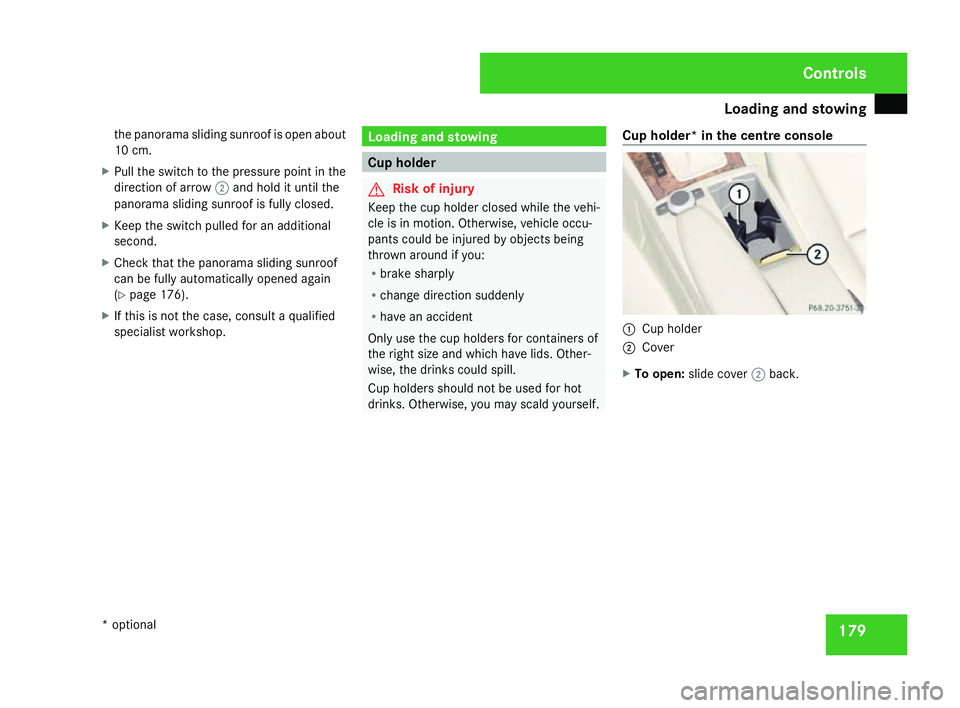
Loading and stowing
179
the panorama sliding sunroof is open about
10 cm
.
X Pull the switch to the pressure point in the
direction of arrow 2and hold it until th e
panorama sliding sunroof is fully closed.
X Keep the switch pulled for an additional
second.
X Check that the panorama sliding sunroo f
can be fully automatically opened agai n
( Y page 176).
X If this is not the case, consult a qualified
specialist workshop. Loading and stowing
Cup holder
G
Risk of injury
Keep the cup holder closed while the vehi-
cle is in motion. Otherwise, vehicle occu -
pants could be injured by objects being
thrown around if you:
R brake sharply
R change direction suddenly
R have an accident
Only use the cup holders for containers of
the right size and which have lids. Other-
wise, the drinks could spill.
Cup holders should not be used for hot
drinks. Otherwise, you may scald yourself. Cup holder* in the centre console 1
Cup holder
2 Cove r
X To open: slide cover 2back. Controls
* optional
204_AKB; 2; 3, en-GB
mkalafa,
2007-06-26T23:11:51+02:00 - Seite 179
Page 183 of 377
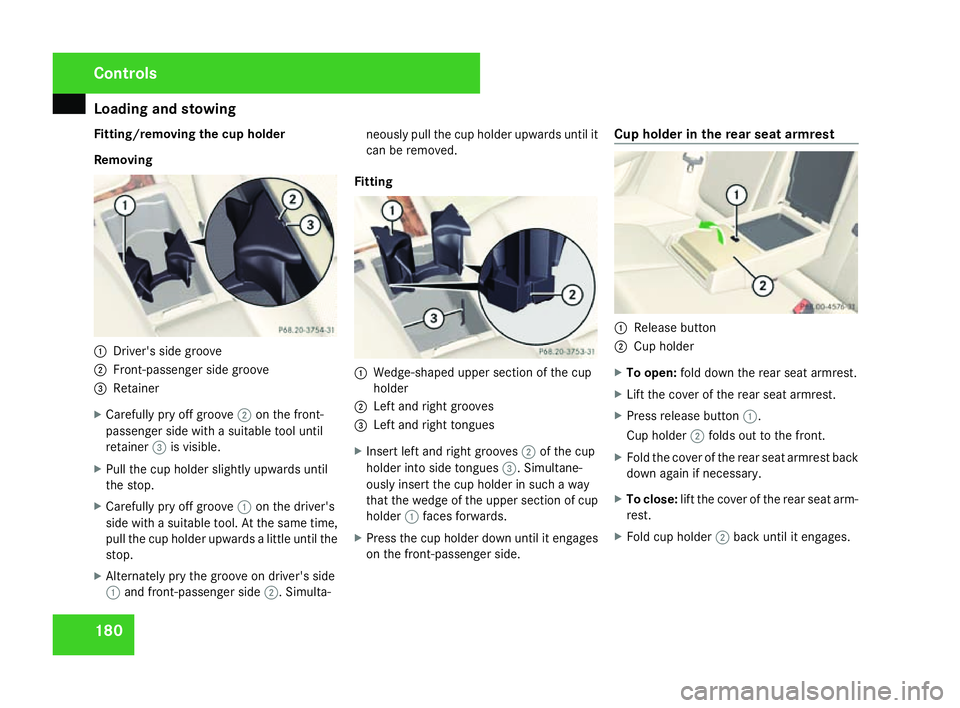
Loading and stowing
180
Fitting/removing the cup holder
Removing
1
Driver's side groove
2 Front-passenger side groove
3 Retainer
X Carefully pry off groove 2on the front-
passenger side with a suitable tool until
retainer 3is visible.
X Pull the cup holder slightly upwards until
the stop.
X Carefully pry off groove 1on the driver's
side with a suitable tool. At the same time,
pull the cup holder upwards a little until the
stop.
X Alternately pry the groove on driver's side
1 and front-passenger side 2. Simulta -neously pull the cup holder upwards until it
can be removed.
Fittin g 1
Wedge-shaped upper section of the cup
holder
2 Left and right grooves
3 Left and right tongues
X Insert left and right grooves 2of the cup
holder into side tongues 3. Simultane-
ously insert the cup holder in such a wa y
that the wedge of the upper section of cu p
holder 1faces forwards.
X Press the cup holder down until it engages
on the front-passenger side. Cup holder in the rear seat armrest
1
Release butto n
2 Cup holder
X To open: fold down the rear seat armrest.
X Lift the cover of the rear seat armrest.
X Press release button 1.
Cup holder 2folds out to the front.
X Fold the cover of the rear seat armrest back
down again if necessary.
X To close: lift the cover of the rear seat arm-
rest.
X Fold cup holder 2back until it engages. Controls
204_AKB; 2; 3, en-GB
mkalafa,
2007-06-26T23:11:51+02:00 - Seite 180
Page 184 of 377
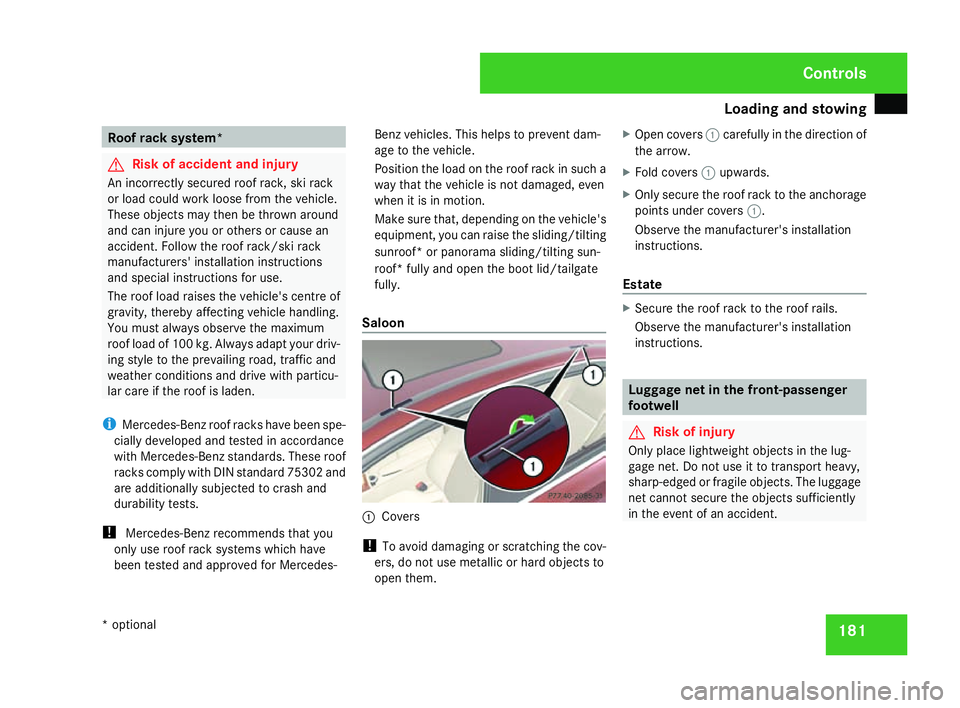
Loading and stowing
181Roof rack system*
G
Risk of accident and injury
An incorrectly secured roof rack, ski rack
or load could work loose from the vehicle.
These objects may then be thrown around
and can injure you or others or cause an
accident. Follow the roof rack/ski rack
manufacturers' installation instructions
and special instructions for use.
The roof load raises the vehicle's centre of
gravity, thereby affecting vehicle handling.
You must always observe the maximum
roof load of 100 kg. Always adapt your driv-
ing style to the prevailing road, traffic and
weather conditions and drive with particu -
lar care if the roof is laden.
i Mercedes-Benz roof racks have been spe-
cially developed and tested in accordance
with Mercedes-Benz standards. These roof
racks comply with DIN standard 75302 and
are additionally subjected to crash and
durability tests.
! Mercedes-Benz recommends that you
only use roof rack systems which have
been tested and approved for Mercedes- Benz vehicles. This helps to prevent dam-
age to the vehicle.
Position the load on the roof rack in such
a
way that the vehicle is not damaged, even
when it is in motion .
Make sure that, depending on the vehicle's
equipment, you can raise the sliding/tilting
sunroof* or panorama sliding/tilting sun-
roof* fully and open the boot lid/tailgate
fully.
Saloon 1
Covers
! To avoid damaging or scratching the cov-
ers, do not use metallic or hard objects to
open them. X
Open covers 1carefully in the direction of
the arrow .
X Fold covers 1upwards.
X Only secure the roof rack to the anchorage
points under covers 1.
Observe the manufacturer's installation
instructions.
Estate X
Secure the roof rack to the roof rails.
Observe the manufacturer's installation
instructions. Luggage net in the front-passenge
r
footwell G
Risk of injury
Only place lightweight objects in the lug-
gage net. Do not use it to transport heavy,
sharp-edged or fragile objects. The luggage
net cannot secure the objects sufficiently
in the event of an accident. Control
s
* optional
204_AKB; 2; 3, en-GB
mkalafa,
2007-06-26T23:11:51+02:00 - Seite 181
Page 185 of 377
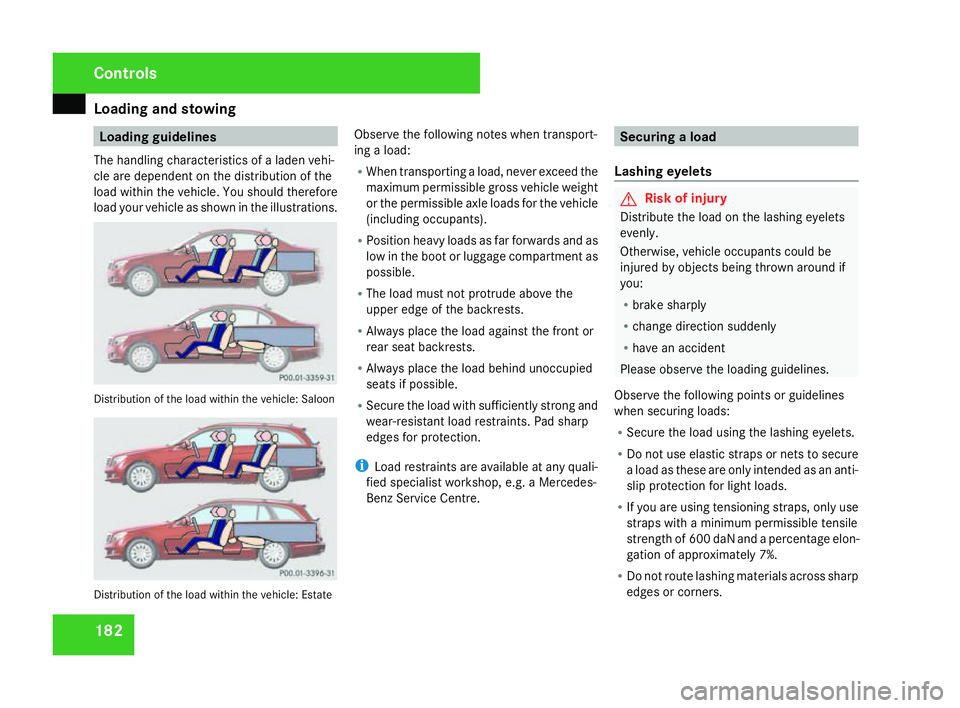
Loading and stowing
182 Loading guidelines
The handling characteristics of a laden vehi-
cle are dependent on the distribution of th e
load within the vehicle. You should therefore
load your vehicle as shown in the illustrations. Distribution of the load within the vehicle: Saloon
Distribution of the load within the vehicle: Estate Observe the following notes when transport
-
ing a load:
R When transporting a load, never exceed the
maximum permissible gross vehicle weight
or the permissible axle loads for the vehicle
(including occupants).
R Position heavy loads as far forwards and as
low in the boot or luggage compartment as
possible.
R The load must not protrude above the
upper edge of the backrests.
R Always place the load against the front or
rear seat backrests.
R Always place the load behind unoccupied
seats if possible.
R Secure the load with sufficiently strong and
wear-resistant load restraints. Pad sharp
edges for protection.
i Load restraints are available at any quali-
fied specialist workshop, e.g. a Mercedes-
Benz Service Centre. Securing a load
Lashing eyelets G
Risk of injury
Distribute the load on the lashing eyelets
evenly .
Otherwise, vehicle occupants could be
injured by objects being thrown around if
you:
R brake sharply
R change direction suddenly
R have an accident
Please observe the loading guidelines.
Observe the following points or guidelines
when securing loads:
R Secure the load using the lashing eyelets.
R Do not use elastic straps or nets to secur e
a load as these are only intended as an anti-
slip protection for light loads.
R If you are using tensioning straps, only use
straps with a minimum permissible tensile
strength of 600 daN and a percentage elon-
gation of approximately 7%.
R Do not route lashing materials across sharp
edges or corners . Cont
rols
204_AKB; 2; 3, en-GB
mkalafa,
2007-06-26T23:11:51+02:00 - Seite 182
Page 186 of 377
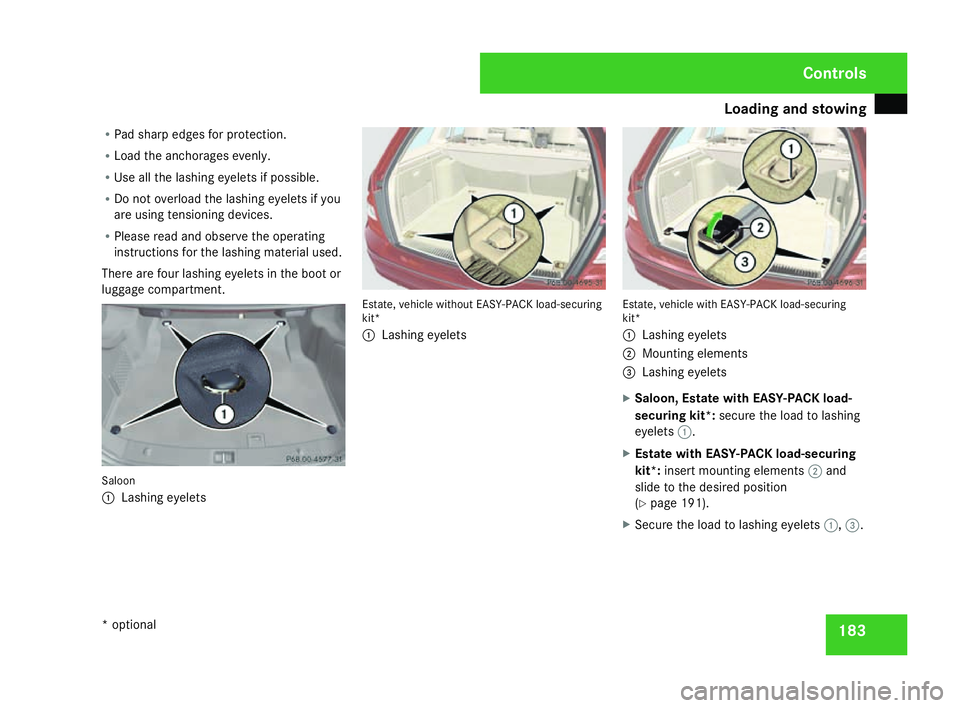
Loading and stowing
183
R
Pad sharp edges for protection.
R Load the anchorages evenly .
R Use all the lashing eyelets if possible.
R Do not overload the lashing eyelets if yo u
are using tensioning devices .
R Please read and observe the operating
instructions for the lashing material used.
There are four lashing eyelets in the boot or
luggage compartment. Saloon
1
Lashing eyelets Estate, vehicle without EASY-PACK load-securing
kit*
1
Lashing eyelets Estate, vehicle with EASY-PACK load-securing
kit*
1 Lashing eyelets
2 Mounting elements
3 Lashing eyelets
X Saloon, Estate with EASY-PACK load-
securing kit*: secure the load to lashing
eyelets 1.
X Estate with EASY-PACK load-securin g
kit*: insert mounting elements 2and
slide to the desired positio n
( Y page 191).
X Secure the load to lashing eyelets 1,3 . Cont
rols
* optional
204_AKB; 2; 3, en-GB
mkalafa,
2007-06-26T23:11:51+02:00 - Seite 183
Page 187 of 377

Loading and stowing
184 Stowage well under the boot floor
(Saloon)
TIREFIT, the vehicle tool kit, etc. are locate d
in the stowage well. 1
Handl e
X To open: pull handle 1upwards. 1
Handl e
2 Rain trough
X Hook handle 1into rain trough 2.
! Unhook the handle before closing the
boot, as you could otherwise damage the
handle. Stowage well under the luggage com-
partment floor (Estate)
G
Risk of injury
Do not carry heavy or hard objects under
the luggage compartment floor if it is ope n
and the objects are not secured.
Otherwise, you and other vehicle occu-
pants could be injured by objects bein g
thrown around the vehicle in the event of
sharp braking, a sudden change in directio n
or an accident .
A removable insert under the luggage com-
partment floor contains the parts of the EASY-
PACK load-securing kit* and a folding box.
TIREFIT, the vehicle tool kit, etc. are stored
beneath this insert. Controls
* optional
204_AKB; 2; 3, en-G
B
mkalafa , 2007-06-26T23:11:51+02:00 - Seite 184